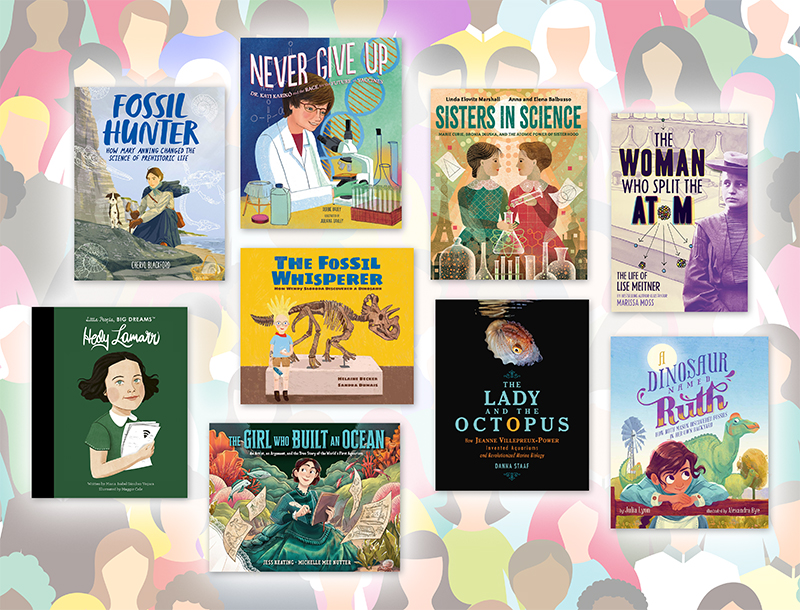9 Nonfiction Titles that Showcase Pioneering Women in STEM
From developing vaccines to discovering dinosaurs, these women have left an indelible mark on the fields of science, technology, engineering, and math.

The Fossil Whisperer: How Wendy Sloboda Discovered a Dinosaur by Helaine Becker. illus. by Sandra Dumais. Kids Can. ISBN 9781525304187.
K-Gr 4–Canadian fossil hunter Wendy Sloboda works in the paleontology department of a museum and travels the world finding fossils wherever she goes. During one of her fossil hunts, she discovers the skeleton of an unknown horned dinosaur and initiates a four-year-long dig with other paleontologists.
Fossil Hunter: How Mary Anning Changed the Science of Prehistoric Life by Cheryl Blackford. HarperCollins/Clarion. ISBN 9780358396055.
Gr 4-8–Along with relating Mary Anning’s experiences seeking fossils and becoming an expert paleontologist before the term existed, this is the story of a girl growing up in the early 1800s. An excellent addition to any collection where there is an interest in paleontology or women’s history.
 Never Give Up: Dr. Kati Karikó and the Race for the Future of Vaccines by Debbie Dadey. illus. by Juliana Oakley. Lerner/Millbrook. ISBN 9781728456331.
Never Give Up: Dr. Kati Karikó and the Race for the Future of Vaccines by Debbie Dadey. illus. by Juliana Oakley. Lerner/Millbrook. ISBN 9781728456331.
Gr 2-6–By working together, Katalin “Kati” Karikó and Drew Weissman came up with a breakthrough that led to the founding of Moderna and was key to the development of the COVID-19 vaccine at Pfizer. Informative as well as inspiring, this book shows how Karikó’s tenacity is proof to never give up.
[Read: Resources and Lesson Plans for Women’s History Month 2022]
A Dinosaur Named Ruth: How Ruth Mason Discovered Fossils in Her Own Backyard by Julia Lyon. illus. by Alexandra Bye. S. & S./McElderry. ISBN 9781534474642.
Gr 2-4–In this charming picture book biography, readers learn about Ruth Mason, a little-known contributor to the world of dinosaurs. After years of collecting bones and writing to experts, Mason was visited by a fossil hunter who confirmed that her treasures were indeed fossils that were millions of years old.
Sisters in Science: Marie Curie, Bronia Dluska, and the Atomic Power of Sisterhood by Linda Elovitz Marshall. illus. by Anna & Elena Balbusso. Knopf. ISBN 9780593377581.
Gr 2-5–Marie Curie is basically a household name, but even adults may have no concept of her background, her family life, or roots. What a gift to read this book and learn more about her similarly talented sister and the rest of her passionate family. Young readers will gain a complete and fully rich picture of Curie and her sister Bronia, who also loved science and studied medicine.
[Read: Seven Picture Book Biographies About Trailblazing Women]
The Woman Who Split the Atom: The Life of Lise Meitner by Marissa Moss. illus. by author. Abrams. ISBN 9781419758539.
Gr 4 Up–Lise Meitner loved physics, and her discoveries were some of the most respected and celebrated in the 20th century. Her story of discovering nuclear fission develops as Nazi Germany comes to power and invades Europe. Eventually, other scientists and governments use her discovery to build the first nuclear bomb, devastating her. Moss presents a spectacular story of history, science, and women’s struggle for respect through the narrative of Meitner’s life.
Hedy Lamarr by Maria Isabel Sanchez Vegara. illus. by Maggie Cole. Frances Lincoln. ISBN 9780711246690.
K-Gr 2–Hedy Lamarr’s story is full of drama—and technology. By focusing on Lamarr’s childhood in Vienna, the book presents an accessible story of a young inventor supported by her family and teachers, and how collaborative STEM work can lead to exciting innovation.
Two titles about Jeanne Villepreux-Power, who invented the aquarium
The Girl Who Built an Ocean: An Artist, an Argonaut, and the True Story of the World’s First Aquarium by Jess Keating. illus. by Michelle Mee Nutter. Knopf. ISBN 9780593305119.
Gr 1-4–Meet the inventor of the first aquarium, 19th-century designer Jeanne Villepreux. Seeking to study ocean animals more closely, Villepreux designed a glass box to observe creatures in their native water habitats. With her aquariums, she was able to make some interesting observations about argonauts, a kind of a squid with a shell.
 The Lady and the Octopus: How Jeanne Villepreux-Power Invented Aquariums and Revolutionized Marine Biology by Danna Staaf. Carolrhoda. ISBN 9781728415772.
The Lady and the Octopus: How Jeanne Villepreux-Power Invented Aquariums and Revolutionized Marine Biology by Danna Staaf. Carolrhoda. ISBN 9781728415772.
Gr 8 Up–Jeanne Villepreux-Power became an expert in many areas of natural history and biology, but her most important accomplishments were in the study of cephalopods and in the development of the apparatus needed for the study of these creatures in their natural environments. This narrative features the compelling story of her life and work in vivid and accessible language.
RELATED
Tide’s Journey
Whose Footprint Is That?
The Tiniest Giant
The job outlook in 2030: Librarians will be in demand
The job outlook in 2030: Librarians will be in demand
ALREADY A SUBSCRIBER? LOG IN
We are currently offering this content for free. Sign up now to activate your personal profile, where you can save articles for future viewing






Add Comment :-
Be the first reader to comment.
Comment Policy:
Comment should not be empty !!!